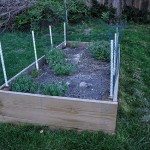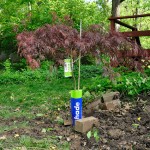
If you live in the Midwest, particularly mid-Missouri where we are, this past weekend was probably the closest we’ll ever come to a monsoon. After several weeks of unseasonably warm and dry temperatures, mother nature rebounded with up to 7 inches of rain and cool blustery temperatures in parts of the midwest. When I left on Friday, I had perfectly green tomato leaves. When I returned I saw this (above), which I can assume is injury or signs of early blight due to over-saturation and cooling of soil temperatures.
After a nearly perfect and effortless growing season last year, I took for granted that not every year will be like that. It is never too early to experience fungal growth, wilt, or even the death of your new tomato plants, so I wanted to pass along a few tips and resources to use as you begin to plant or transplant your new tomatoes. What may look like just a “spot” could represent any one of dozens of inflictions caused by a unique set of circumstances.
For Optimum Growth/Disease Resistancy, Always:
- Improve garden soil by adding organic material such as compost. A great beginner guide to composting can be found here.
- Be on the look out for disease-resistant seed varieties. They’ll be labeled on the seed packet.
- Eliminate competition by keeping your garden weeded at all times.
- Keep plants growing vigorously with proper water and nutrients. A good way to measure what to add is to use plant leaves as a gauge for nutrient excess and deficiency. The color and condition of your leaves will say a lot.
- Keep the garden clean of plant debris, including dead plants, pulled weeds or grass clippings.
- Rotate crops and till/turn your soil each year. Remember, earthworms are a beneficial insect!
- Space plants for maximum air circulation. More plants do not necessarily mean more fruits and veggies!
- Don’t wait until it’s too late! Inspect your plants regularly for pests or disease. Spotting problems early gives you the best shot at resolving them with lesser invasive treatments.
Additional Tomato Gardening Resources:
- Growing Home Garden Tomatoes
- Tomato Problem Solver – Great Diagnostic Tool from Texas A&M
- Disease Prevention in Home Vegetable Gardens
- Fresh Market Tomatoes – For growing high-volume
You may also like






